Trudy J. Morgan-Cole's Blog, page 28
April 22, 2022
The Warmth of Other Suns, by Isabel Wilkerson
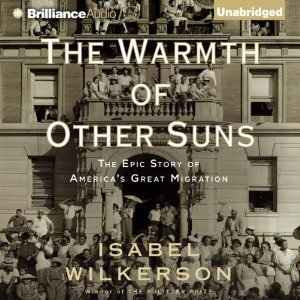
This was a very long audiobook that took me several weeks (on and off) to listen to, but it was well worth it. It’s a very detailed (though for a general audience, not scholarly) analysis of the Great Migration, the movement of Black people from the American south beginning during the First World War and continuing until the civil rights era in the 1960s and early 70s. The breadth and scope of this book is impressive, sweeping through several decades of American history and looking at the reasons for the migration and the impacts of it in many different Northern and Western cities where the migrants settled. However, this broad scope is balanced by a personal focus: out of the many migrants Wilkerson interviewed in the 1990s when most were elderly, she chose three individuals — one woman and two men — who all migrated from different places in the South, to different Northern cities, in different decades (the 30s, 40s and 50s), and traces each of their stories throughout their lives. Telling the story in this way — three individual histories unfolding against the background of the much bigger story of two or three generations of migrants seeking freedom and better lives — makes the whole movement come alive for the reader. We see the horrific Jim Crow-era racism that forced these people to leave — and also the more veiled but just as real racism that they faced in the North upon arrival. This book is social history at its best and I learned so much from it.
How to Be Champion, by Sarah Millican
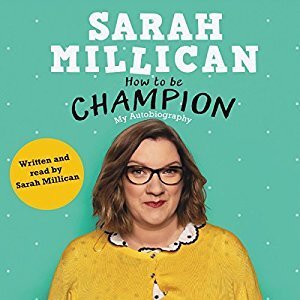
Following immediately upon the heels of Bob Mortimer’s And Away… (and not unrelated to a very long two-day drive Jason and I just went on), How to Be Champion is another entry in the “UK comedians I like who are reading their own life stories” category. I love Sarah Millican’s humour, and in this 2017 memoir she writes about childhood, growing up, being bullied, being a weird nerdy little kid and teenager, getting married very young, getting divorced, getting into comedy, being a woman, having periods, not wanting children, falling in love again, having body image issues, feminism, being a target of online hate, and so many other things. There’s also a bit of light-hearted self-help in each chapter in the form of Sarah’s “tips on how to be champion” (she also explains what “champion” means, in her North-of-England dialect, in case you’re not clear). Funny and often insightful.
And Away…, by Bob Mortimer
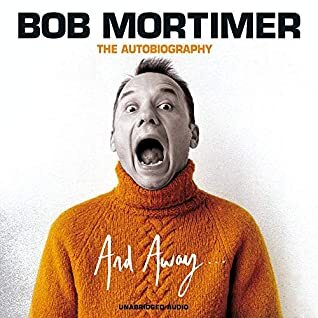
One of my favourite audiobook categories is “UK comedians reading their own memoirs” and as Bob Mortimer is a favourite of mine in the world of comedy, it was unsurprising that Jason and I would both enjoy listening to his memoir. Mortimer structures the story of his life and career around his 2015 heart attack, surgery, and recovery, switching back and forth from 2015 to the more distant past as he tells the story of the life he lived leading up to that event, his career in comedy, and what he learned and the changes he made after almost dying. Some serious thoughts here, but mostly the tone is light and there’s some very, very funny observations. Also, if you watch Bob Mortimer’s frequent appearances on Would I Lie to You, as we do, you’ll realize the reason his most outrageous stories are usually true — he has an incredible gift for taking incidents from his life and telling them in the most unforgettable ways (plus, he has done some really weird stuff)! Thoroughly enjoyable, though, like most celebrity memoirs, probably mostly enjoyable if you know the man and his work.
April 17, 2022
This Land is Their Land, by David J. Silverman
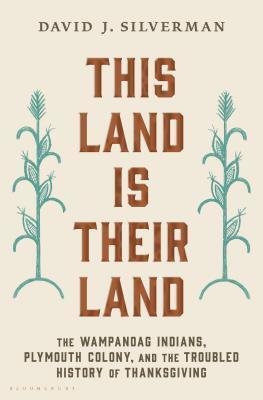
As this book’s subtitle suggests, it takes on the familiar American origin story of the “first Thanksgiving” and demythologizes it, telling the real story of encounters between the English settlers at Plymouth/Patuxet, and the Wampanoag people who were (and are!) native to that area. In fact, the book goes far beyond the traditional and much-misrepresented Thanksgiving story, and is a thorough history of the Wampanoag in the century immediately before and after the settler landing of 1620.
An important caveat going into this book is that the author is a settler historian whose area of study is colonial and indigenous American history; he is not himself Wampanoag or Indigenous at all. So, while he spoke extensively to contemporary Wampanoag people as well as doing the usual historical research, he acknowledges that this is not a Wampanoag telling of their history and that his version differs from Wampanoag oral tradition at some key points. With that in mind, this is still an important book. Scholar have access to many, many written accounts of settlers’ interactions with the Wampanoag and even some documents written (both in England in their own language) by Wampanoag people themselves, so there is a rich trove of material that allows a scholar to recreate much of what can be known about these people and their world.
I picked this book up because I am researching the life of Tisquantum, the Wampanoag man who spent some time in Newfoundland, probably at the Cupids colony, around 1617-1618. He was later known to the Plymouth settlers as Squanto, who acted as a translator for the Wampanoag sachem, but I was interested in finding out as much as I could about the culture he would have come from before being abducted and sold into slavery by an English captain (which was the beginning of the long journey that led him to Newfoundland and eventually back home to Patuxet). I found this book a really interesting, detailed and insightful telling of the first years of English settlement in what is now New England, told with the focus not on the settler experience, as usual, but on the Indigenous experience. The book covers in details up to the time of the Wampanoag uprising that the English called “King Philip’s War,” and then in two brief chapters at the end summarizes what happened to the Wampanoag people in the 350 years following those events and the attempts of current-day Wampanoag people to reclaim their land, culture, language and history.
April 16, 2022
The Verifiers, by Jane Pek
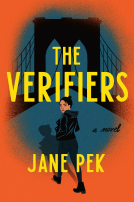
This is one of my favourite new novels, and definitely my favourite mystery, that I’ve read in awhile. I raced through it in 24 hours and I sincerely hope there’s going to be a sequel. I could read a whole series of mysteries starring amateur sleuth Claudia Lin, a twenty-something New Yorker who works at a shadowy start-up whose job is to “verify” the identities of people their clients meet through online dating. The founder of the company insists they’re not detectives, but Claudia really, really wants to be, and when one of Veracity’s clients, who has been making odd and unusual requests of the verifiers, turns up dead, it’s Claudia’s moment to put all her fantasies of being just like her favourite fictional detective into reality.
I loved so much about this novel — the mystery itself, the deeper and troubling questions it explores about the use of our data online to not only predict but influence our behavior, the vivid descriptions of New York City as Claudia, a dedicated cyclist, wheels through it. Mostly, I loved Claudia as a smart, witty first-person narrator, and the complicated dynamics of her family with her Chinese immigrant mother and two siblings. This is rich, brilliantly drawn main character/amateur detective surrounded by interesting and well-developed secondary characters, and there’s so much material here — even a mystery-within-the-mystery left tantalizingly dangling at the end of the book — that cries out for a sequel or, ideally, a series. I really hope there will be more of Claudia.
April 13, 2022
French Braid, by Anne Tyler
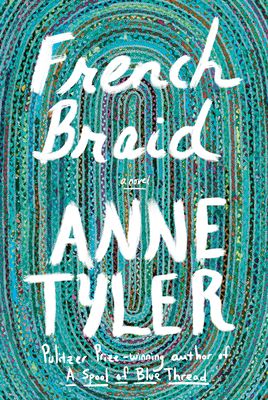
The last Anne Tyler novel I read, Redhead by the Side of the Road, dealt with one of her classic storylines: a lonely man who avoids meaningful connection with others. French Braid picks up another common Tyler thread: a large, multigenerational family (in Baltimore, of course), and the relationships between them, the loneliness that can exist within the seemingly tightly-braided network of an extended family.
The novel begins with a simple and telling scene in a train station in 2010: college student Serena, heading home from a trip with her boyfriend, sees her first cousin Nicholas from a distance but doesn’t speak to him, because she’s not sure a) if it’s him, and b) if he would know her. Her boyfriend is amazed that a family can be so distant that first cousins wouldn’t recognize each other in a train station (they live in different US states, but not particularly far apart, so it’s not as if they’ve grown up separated by continents).
Then, we get the backstory of this family, beginning with Serena’s and Nicholas’s grandparents, Mercy and her husband Robin, taking their first and last family vacation with their three children in the summer of 1959. Moving forward in chapters spaced roughly ten years or so apart, we get brief glimpses into the lives of the Garrett family, shifting point of view from one character to another, exploring not just the connections that tie families together but also the spaces that push them apart.
There’s no big secret to be revealed here, no shocking moment when we discover the horrible event that drove the Garretts apart. Rather, there’s a series of little secrets, little lies, little misunderstandings — as well as little moments of warmth, love, and connection — unfolding over the decades. It’s a story both big and small, told with the loving attention to detail that we always get from an Anne Tyler novel, with warmth, humour, and an overarching sense (for me at least) of melancholy: why can’t all these good people be a little better at showing how much they care for each other?
A Marvellous Light, by Freya Marske
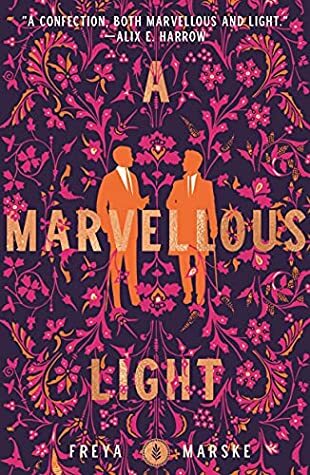
This is an urban fantasy set in a version of Edwardian England where a secret world of magicians exists alongside everyday reality, unknown and unrecognized by most ordinary people. Young aristocrat Robin Blyth is one such person, not even suspecting the existence of magic until a seemingly innocuous job in the civil service throws him into the midst of a magical conflict — and into the company of Edwin Courcy, a dedicated scholar from a magical family who is, by the standards of his own world, deficient in actual magical skills. Once Robin and Edwin start (unwillingly, at first) spending time together in an attempt to remove a curse another magician has placed on Robin, it becomes clear this is a historical urban fantasy and a romance (definitely of the “steamy” rather than the chaste variety; I always like to put those warning labels on romances since people have very different tolerance levels for how graphic they like love scenes to get, and this is on the more-graphic end). The magic is interesting; the plot moves along well; the two characters are genuinely likeable which makes it much easier to cheer for their romance. It’s also the first in a series, with a second book to come out in the fall, focusing on a different character from this first book. I enjoyed this enough that I will most likely be reading the next book when it’s available.
April 2, 2022
New Girl in Little Cove, by Dahmnait Monaghan
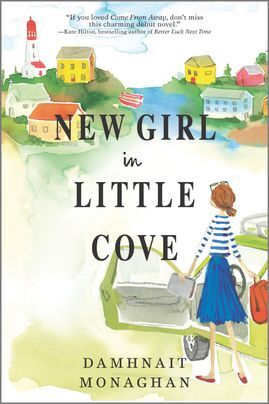
This is a delightful novel that somehow flew under my radar when it came out last year. I read it in less than 24 hours and found that, while generally light in tone and heart, it was completely compelling.
The story is set in 1985, when Rachel arrives from Ontario to teach French in a tiny Newfoundland outport. It’s pre-moratorium, so most of the men in the community are still fishing, and it’s pre-end-of-denominational-education, so Rachel has to cross her fingers and promise she’s an observant Catholic before she can get the job at St. Jude’s. Even more troubling, the local priest sits her down for a little talking-to about the importance of upholding Catholic values in her teaching, in her encounters with students, and in her personal life — intrusive, but perhaps relevant as the previous French teacher ran away with the previous priest.
There’s lots of great local characters, insightful and humourous depictions of rural Newfoundland life in that era, painfully accurate scenes of the trials and tribulations of being a first year teacher, and a gently-blossoming romance to sweeten the story. There were definitely elements here I could relate to — my first year teaching was 1986, the year after Rachel’s, although in my case the journey was in the opposite direction, from Newfoundland to Ontario.
Author Dahmnait Monaghan, who lives in the UK but has Newfoundland roots, hits that sweet spot that so many of the best writers of what’s often dismissively called “women’s fiction” are good at: a light tone with lots of humour occasioned by Rachel’s fish-out-of-water status in a fishing community, but with that lightness, touching on some deep topics. Yes, this is about a mainlander finding her place in a tiny remote outport, about a first-year teacher learning the ropes, about a lapsed Catholic trying to fit in in a place where everyone, especially a teacher, is expected to show up for Mass every Sunday. But it’s also about recovering from grief, and about the tough moral choices you sometimes have to make when your personal convictions chafe against what your job demands. It’s also, while being amusing, a loving and respectful look at Newfoundland outport life as it was 35 years ago. One of the strongest parts of the novel is Rachel’s reaction to the Newfoundland dialect around her (which is very well rendered, not always the case in fictional portrayals of outport life) and how she learns, or is taught, to question her own assumptions about that dialect. She’s come to teach French, but she finds herself learning another language as well.
Sweet, sincere, and surprisingly thought-provoking in spots, New Girl in Little Cove was a quick read and one I found completely absorbing.
March 31, 2022
Death of a Dandy, by Riana Everly
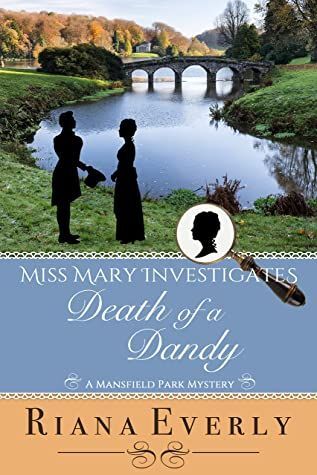
As with the two previous mysteries in this series, Death of a Clergyman and Death in Highbury, this novel inserts Mary Bennett and her private-investigator friend Alexander Lyons into an existing Jane Austen novel, and adds a twist of murder. In this case the novel is Mansfield Park, an Austen novel I don’t know very well (I’ve read them all at least once, but I’ve never felt the urge to revisit Mansfield Park). As always, murder occurs in the middle of the already-known Austen story with its familiar characters, and Mary and Alexander conveniently happen to be in the neighbourhood to solve the crime.
I found this one, which begins with Edmund Bertram hiring Alexander to look into his brother Tom’s mysterious disappearance, to be an intriguing mystery with some unexpected twists, although, as always, what I enjoyed most is the continuing development of Mary Bennett’s character and her relationship with Alexander. I eagerly await the next installment in Miss Mary Investigates.
March 27, 2022
The School of Mirrors, by Eva Stachniak
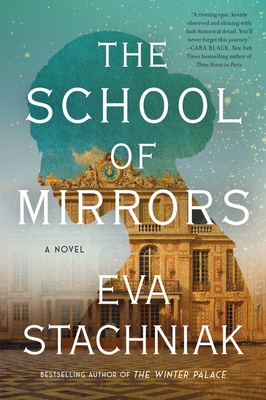
Even though we all know “people thought differently back then,” it’s still a bit of a shock to learn that in 18th century France, King Louis XV, in addition to having a wife and an official mistress, also had a staff member specifically tasked with seeking out beautiful, very young girls (we’re talking early teens here), having them brought to a house near his palace at Versailles, and vetting and training them for the royal bedchamber. Not exactly a harem, especially as it’s doubtful whether more than one or two girls at a time were there and it was in no sense a permanent appointment, but the house called Deer Park is pretty close. The girls there are told that the lover they are brought to the palace to meet is a Polish count, a relative of the Queen; most have no idea they are actually in bed with the King of France.
From the few scant references to this house and its denizens in historical records, Eva Stachniak has woven the story of Veronique, a poor girl snatched from the streets of Paris to be brought to the King’s bed, and the daughter she bears the King, Marie-Louise. The story sweeps from the reign of Louis XV to that of his grandson, Louis XVI, and the Revolution that will cost him his throne and his life. The growing sense of chaos, dread, and fear as the Revolution spins out of control is well-drawn, with the vividly realized midwife Marie-Louise struggling to keep her family safe amidst it all. This is a big, epic story that sweeps us through a turbulent half-century of history with a wonderful eye to detail.



